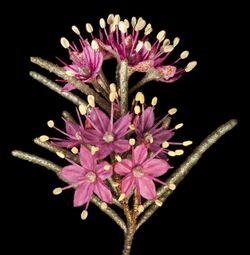Biology:Phebalium canaliculatum
| Phebalium canaliculatum | |
|---|---|

| |
| Near Lake Moore, Western Australia | |
| Scientific classification | |
| Kingdom: | Plantae |
| Clade: | Tracheophytes |
| Clade: | Angiosperms |
| Clade: | Eudicots |
| Clade: | Rosids |
| Order: | Sapindales |
| Family: | Rutaceae |
| Genus: | Phebalium |
| Species: | P. canaliculatum
|
| Binomial name | |
| Phebalium canaliculatum (F.Muell. & Tate) J.H.Willis[1]
| |
| Synonyms[1] | |
|
Eriostemon canaliculatus F.Muell. & Tate | |
Phebalium canaliculatum is a species of erect shrub that is endemic to the southwest of Western Australia. It is more or less covered with silvery and rust-coloured scales and has thin, cylindrical leaves and dark pink to pale mauve flowers in umbels on the ends of branches.
Description
Phebalium canaliculatum is an erect shrub that typically grows to a height of 0.4–2 m (1 ft 4 in–6 ft 7 in) and is more or less covered with silvery and rust-coloured scales. The leaves are cylindrical to slightly flattened, about 25 mm (0.98 in) long and 1.5 mm (0.059 in) wide on a very short petiole. The flowers are dark pink to pale mauve and arranged in sessile umbels on the ends of branchlets, each flower on a pedicel 4–7 mm (0.16–0.28 in) long. The sepals are about 1 mm (0.039 in) long and joined for about half their length, scaly on the outside but glabrous inside. The petals are elliptical, 4–5 mm (0.16–0.20 in) long and 2–3 mm (0.079–0.118 in) wide, covered with silvery scales on the outside. The filaments of the stamens are pale mauve with a yellow anther. Flowering occurs in May or from July to October.[2][3][4][5]
Taxonomy and naming
This species was first formally described in 1896 by Ferdinand von Mueller and Ralph Tate from specimens collected by James Drummond "towards Ularing" during Giles's third expedition. It was given the name Eriostemon canaliculatus and the description was published in the Transactions of the Royal Society of South Australia.[6][7] In 1958, James Hamlyn Willis changed the name to Phebalium canaliculatum, publishing the name change in The Victorian Naturalist.[4][8]
Distribution and habitat
Phebalium canaliculatum grows on sandplains and hillslopes, sometimes on rock outcrops, in shrubland or mallee between Wongan Hills, Sandstone and Kalgoorlie.[2][5][9]
Conservation status
Phebalium canaliculatum is classified as "not threatened" by the Western Australian Government Department of Parks and Wildlife.[2]
References
- ↑ 1.0 1.1 "Phebalium canaliculatum". Australian Plant Census. https://biodiversity.org.au/nsl/services/apc-format/display/81412. Retrieved 14 June 2020.
- ↑ 2.0 2.1 2.2 "Phebalium canaliculatum". FloraBase. Western Australian Government Department of Parks and Wildlife. https://florabase.dpaw.wa.gov.au/browse/profile/4497.
- ↑ Wilson, Paul G. (1970). "A Taxonomic Revision of the Genera Crowea, Eriostemon and Phebalium (Rutaceae). Nuytsia 1(1)". Nuytsia 1 (1): 66–67. https://www.biodiversitylibrary.org/item/223300#page/72/mode/1up. Retrieved 14 June 2020.
- ↑ 4.0 4.1 Willis, James Hamlyn (1957). "A Distinctive West Australian Phebalium (Rutaceae)". The Victorian Naturalist 74: 169. https://www.biodiversitylibrary.org/item/127326#page/171/mode/1up. Retrieved 14 June 2020.
- ↑ 5.0 5.1 Wilson, Paul G.. "Phebalium canaliculatum". Australian Biological Resources Study, Department of Agriculture, Water and the Environment, Canberra. https://profiles.ala.org.au/opus/foa/profile/Phebalium%20canaliculatum. Retrieved 15 June 2020.
- ↑ "Eriostemon canaliculatus". APNI. https://id.biodiversity.org.au/instance/apni/470219. Retrieved 14 June 2020.
- ↑ von Mueller, Ferdinand; Tate, Ralph (1896). "Botany. Phanerogams and Vascular Cryptogams.". Transactions of the Royal Society of South Australia 16 (3): 337. https://www.biodiversitylibrary.org/item/110683#page/346/mode/1up. Retrieved 14 June 2020.
- ↑ "Phebalium canaliculatum". APNI. https://id.biodiversity.org.au/instance/apni/497922. Retrieved 14 June 2020.
- ↑ Corrick, Margaret G.; Fuhrer, Bruce A. (2009). Wildflowers of Southern Western Australia. Dural, N.S.W.: Rosenberg Publishing. p. 196. ISBN 9781877058844.
Wikidata ☰ Q18076550 entry
 |

